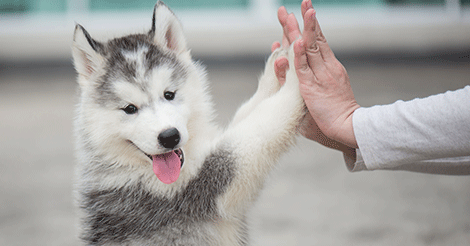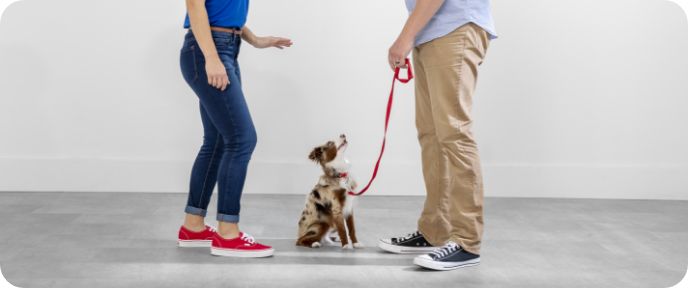Puppy Training Techniques: Teaching Basic Commands for a Happy Pet
Puppy Training Techniques: Teaching Basic Commands for a Happy Pet
Blog Article
Top Puppy Training Methods to Make Certain a Mannerly Pet Dog
Efficient puppy training is vital for cultivating a mannerly buddy, and various strategies can dramatically affect a dog's growth. Among these, favorable support stands apart as a fundamental method, promoting depend on and motivating desirable behaviors. Consistency in commands and early socializing are equally crucial, laying the groundwork for a well-adjusted animal. Furthermore, the functions of pet crate training and chain decorum can not be ignored. As we explore these techniques better, it comes to be clear that the success of young puppy training pivots on a combination of approaches that can transform your animal's habits in amazing ways.
Favorable Support Techniques
Making use of favorable support strategies is essential for efficient puppy training, as it urges preferred actions through incentives rather than penalty. This approach capitalizes on the natural knowing processes of pet dogs, strengthening etiquette by offering concrete and prompt rewards, such as treats, appreciation, or playtime. By associating favorable outcomes with particular activities, young puppies are more probable to duplicate those actions in the future.
Efficient favorable support entails timing and uniformity. Incentives should be given immediately after the desired habits strikes develop a clear link in the young puppy's mind. Furthermore, varying the sorts of rewards can preserve a puppy's passion and inspiration throughout the training process. Some puppies may respond far better to spoken praise while others may like a preferred plaything or reward.

Uniformity in Educating Commands
Maintaining uniformity in training commands is essential for enhancing the lessons learned via favorable support methods. Pet dogs thrive on regular and predictability, so making use of the exact same spoken commands and hand signals for certain behaviors is crucial. This harmony assists puppies comprehend what is anticipated of them, minimizing confusion and irritation for both the family pet and the trainer.

Timing likewise plays a considerable function in consistency. Commands need to be delivered promptly during training sessions and followed promptly by favorable reinforcement, such as treats or praise. This immediate action helps solidify the organization in between the command and the wanted actions.
Including uniformity right into training sessions will certainly develop a stable learning setting, promoting quicker proficiency of commands. Ultimately, a well-structured approach cultivates a solid bond between the puppy and its proprietor, resulting in a much more loyal and well-behaved animal.
Socializing With Various Other Pet Dogs
Socializing with various other pets is critical for a puppy's advancement, as it assists them find out suitable behaviors and communication skills in diverse social contexts. Very early communications with different animals can substantially influence a pup's personality and flexibility in various situations. When pups are subjected to a variety of pet dogs, they come to be extra certain and less frightened, which can avoid possible behavior issues later on in life.

Moreover, observing body language during communications is vital. Show your pup to acknowledge signals from various other animals, such as signs of playfulness or pain, promoting mutual respect and understanding. Routine socializing not just enhances your pup's social abilities but likewise adds to their general well-being, creating a more harmonious living atmosphere. To conclude, prioritizing interactions with other family pets will generate a socially experienced and all-round dog.
Crate Training Conveniences
Acknowledging the many advantages of cage training can significantly improve both the young puppy's and owner's experience. Crate training supplies a protected and risk-free setting for puppies, ensuring they really feel protected when left alone. This feeling of security can significantly reduce stress and anxiety and anxiety levels for both the owner and the pet.
Furthermore, crates act as a useful house-breaking tool. Young puppies normally stay clear of staining their resting location, thus encouraging them to hold their bladder until they are allow outdoors. This instinct can expedite the housebreaking procedure, promoting good habits beforehand.
Crate training also assists in managing a puppy's habits when unsupervised. By providing an assigned area, proprietors can protect against damaging actions, such as chewing on furniture or getting involved in harmful compounds. Moreover, dog crates can be beneficial during travel, providing a familiar area that can aid soothe a pup in new atmospheres.
Lastly, establishing a cage regular urges independence, enabling young puppies to learn how to be alone without fear. Generally, crate training is an effective method for promoting safety and security, discipline, and peace, leading to a well-adjusted, well-behaved pet dog.
Leash Training Fundamentals
Leash training is an essential element of responsible family pet ownership that guarantees a delightful image source and secure walking experience for both the young puppy and its owner. Appropriate leash training starts early, ideally throughout the pup's socializing duration. This training helps establish good practices and promotes positive habits when out in public.
To begin, choose a comfy collar or harness that fits your young puppy well. Attach a tough chain, guaranteeing it is not too long, as article this can cause pulling and erratic habits. Beginning in a peaceful atmosphere to reduce interruptions and slowly introduce your young puppy to new environments.
Use positive reinforcement methods, such as deals with and appreciation, to encourage your pup to walk beside you. If your pup pulls, stop walking and await them to return to your side before proceeding. This educates them that drawing will certainly not yield ahead activity. Uniformity is essential; practice regularly and stay patient, as mastery takes time.
In addition, include brief training sessions with fun interruptions to develop your young puppy's emphasis. With commitment and persistence, leash training will certainly cause an accommodating friend, making strolls pleasurable for both the proprietor and the pup.
Conclusion
In verdict, employing efficient pup training methods is important for creating a well-behaved animal. In general, these techniques collectively promote a harmonious connection in between puppies and their owners.
As we check out these approaches further, it ends up being clear that the success of pup training pivots on a combination of techniques that can change your pet dog's behavior in amazing methods.
Making use of favorable useful content reinforcement techniques is necessary for reliable pup training, as it encourages desired habits with incentives instead than penalty.Crate training additionally aids in handling a pup's behavior when without supervision.Leash training is a basic facet of liable pet ownership that ensures a risk-free and pleasurable strolling experience for both the young puppy and its proprietor.In final thought, utilizing efficient young puppy training methods is important for establishing a well-behaved animal.
Report this page